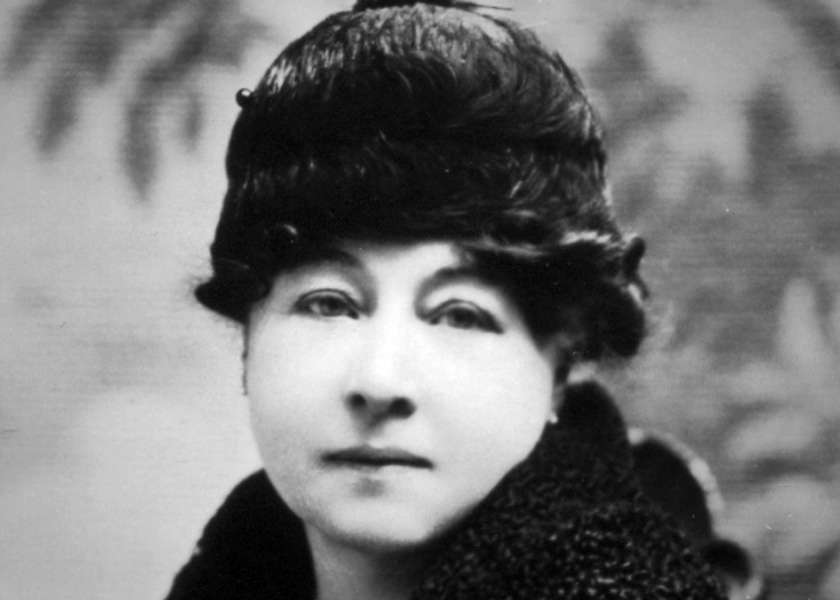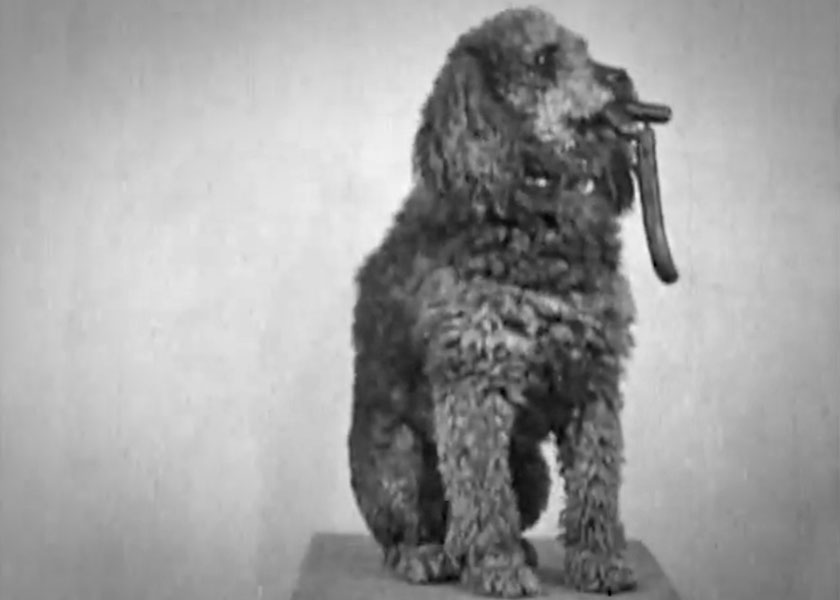Synopsis
The film opens and closes with a shot of a cute, curly-haired dog, its tongue hanging out, sitting on a stool and looking at the camera. The first scene shows a barrel on the sidewalk in front of a grocery store. A string of sausages lies on top of the barrel. The curly-haired dog seizes the string of sausages and runs off with it. The grocer comes out of the store, makes an excited gesture, and grabs the other end of the string. The string hold together as the dog pulls the grocer away. The grocer’s wife follows, waving her arms.
The dog runs along a street pulling the grocer. The wife follows. Two more women, a man with a pitchfork, and a group of boys join the chase after the dog. The dog, pulling the grocer, runs past two women, knocking them down, and continues down a flight of steps. The pursuers, grocers, men, women, and boys, run over the two women who get up and join the chase. The dog, pulling the grocer, runs past a pair of painters on a platform. As the chasers rush by, they upset the platform and crush it. The painters, knocked to the ground, get up and run after the crowd.
The dog runs past a uniformed nursemaid pushing a baby carriage. The sausage string wraps around a wheel. As the grocer runs by, the pram is pulled over. The pursuers run by, knocking the pram over again. The nurse, pushing the pram, runs after the crowd. The dog runs through a fence and past a woman with a small cart containing two pigs and a can of milk. The sausage string pulls over the cart, spilling the milk. Pursuers fall over the cart. The woman wrestles with her pigs. Two men are walking along the base of a steep embankment. The dog runs down the slope. The grocer, still holding the end of the string of sausages, rolls down the slope behind him. The pursuers run or roll down the slope, knocking over the two men. Everybody rushes off after the dog.
The dog runs by an acrobat, dressed in tights, who is setting up hoops. The crowd of pursuers break the hoops, and the costumed acrobat joins the chase. The dog leaps through an open window, the grocer follows. The woman in the room, plucking a chicken, jumps up in alarm. The pursuers, 18 men and women, follow through the window. They trample bags of feathers, scattering them all over the room. The woman strikes out wildly with the dead, plucked chicken. The painters, the last pursuers, slip and slide through a roomful of flying feathers. The dog runs down a railroad track. The pursuers cross just before a small train passes. The nurse picks up the baby and rushes on. The train runs over the abandoned baby carriage.
A hunter with a shotgun is looking for birds as the dog runs by. He shoots the string of sausages and breaks it. He starts to eat a sausage. The crowd stops, and everybody starts to eat the sausages. The angered grocer tries to stop them. The dog is sitting on the stool, now with a couple of sausages in its mouth.
Discussion

Course à la saucisse (The Race for the Sausage) exemplifies one of the earliest types of narrative film, the comic chase. By 1907, story films had become extremely popular with audiences. These films had simple story lines and brief running times. This film, lacking intertitles, is only four minutes long, less than half a reel. The comic chase, with its uncomplicated pattern of similar scenes and emphasis on pratfall comedy, was an easy subject on which to devise a plot line.
The film consists of thirteen scenes. The dog sits alone in the first and last. In most of the other eleven scenes, the dog, carrying the sausage string and pulling the grocer, enters from the right and exits to the left; the pursuers follow him on the same path. In each scene, people are upset, fall down, objects are broken, and general disruption results from the passage of the crowd chasing the dog. The train runs over the abandonned baby carriage, the nurse removing the baby just in time. The film ends with the hunter’s shot breaking the string of sausages and the pursuers eating them to the dismay of the grocer.
The series of scenes, mostly equal in length, do not build tension or lead to a climax in the story. The story reaches an undramatic ending when the sausage chain is broken, and the chase ends. Some scenes are funnier than others and the chicken plucking episode is longer and more complex, but no scene is given any particular emphasis or specialized position within the film. The chase ends with a final incident, the hunter’s shot, that separates the sausages, and the grocer, from the dog. The first and last shots enclose the chase scenes with views of the perky dog but have no other meaning.
In each scene, the camera has a fixed position, usually toward to the left side of the screen, facing toward the right, although the position can be reversed. If the camera is at the left and faces toward the right, the dog enters from the right and runs toward, and out of, the left of the frame, and the action is in the opposite direction if the camera faces left. After every person has run through, the scene has ended. The camera is moved and takes a fixed position for the next scene. By this point, film language had developed an initial set of narrative expectations in the minds of the viewers. Although the film does not uninterreputedly follow the participants throughtout the entire chase, the viewers recognize a continuity of time and space between each scene of dog and pursuers.
All shots show the entire bodies of the actors and include some of the pavement under their feet and space over their heads. Only the opening and closing shots of the dog, who is the only individualized character, are slightly closer views. The actors are indistinguishable except by sex, and most, if not all, of the women characters are played by men cross-dressed as women in long dresses, pantaloons and caps. As was typical for French chase films, the pursuers, usually played by circus acrobats and clowns, do a lot of pratfalls. Also typical for a chase film, some characters, the grocer, nursemaid and acrobat, are easily identified stereotypes, although most pursuers are in plain dress.
Alice Guy, the first woman film director, may have made this film in France during her final year working for the Gaumont Chronophone Company. Starting in 1896, she made hundreds of short films for Gaumont. The attribution of films during this early period can be difficult. Film companies did not identify the individuals involved in film production. Although Alice Guy has been named on recent releases as its director, it is possible the film was made by Louis Feuillade or Romeo Bosetti, her principal assistants at Gaumont during her final years with the company.
In 1908, the newly married Alice Guy-Blaché sailed to New York with her husband, Herbert Blaché. Two years later, she renewed her film career, making one-reel films for her own production company, Solax Films, located first in New York and later in New Jersey.
Further Reading

